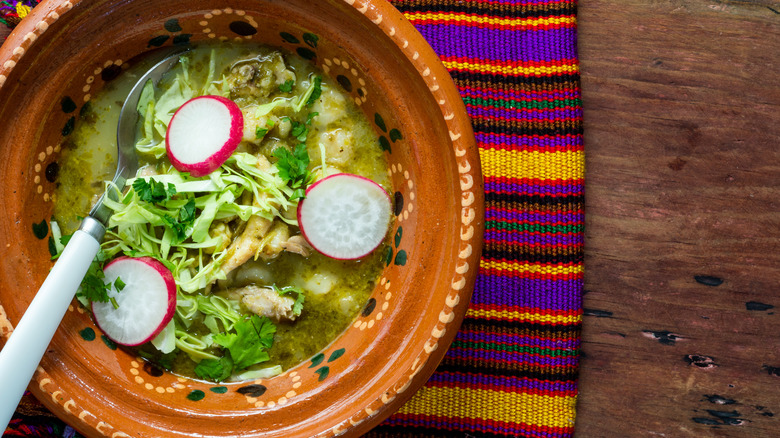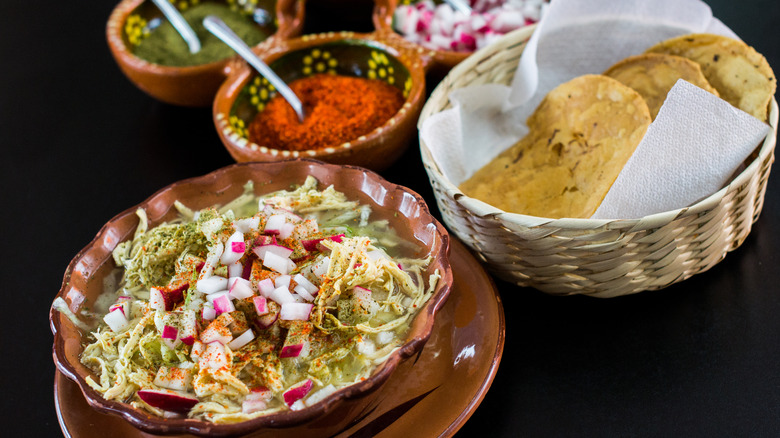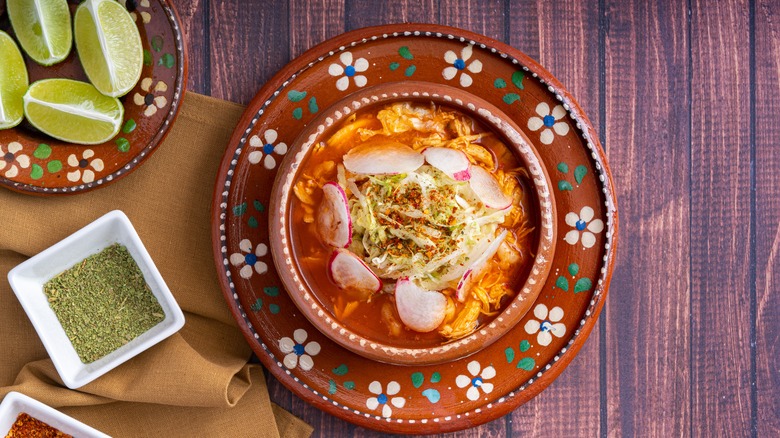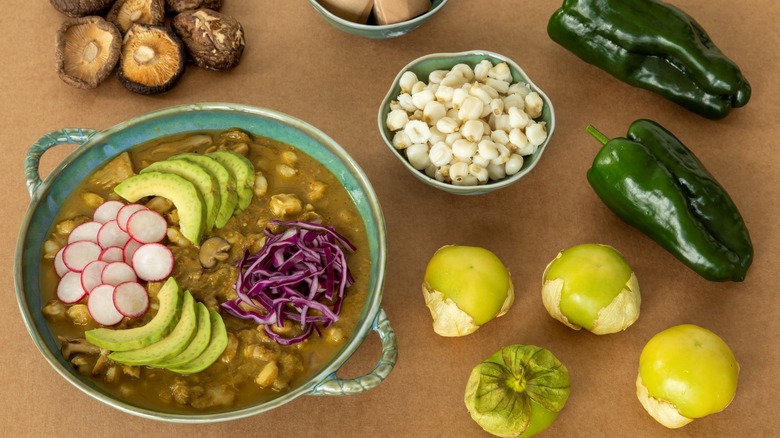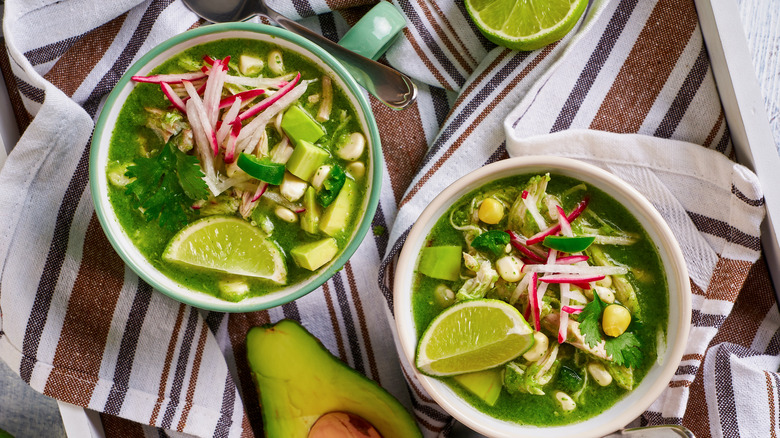Pozole Verde: The Vibrant Mexican Soup You Should Know
Some people only turn to soups as days get shorter and the temperatures dip, but we think it should be soup season year-round. And while you might instinctually reach for a can of chicken noodle or butternut squash puree, it would be a mistake to sleep on Mexican soups for that comforting bite.
A classic choice is tortilla soup, which TasteAtlas describes as a Mexico City specialty that includes flavorful ingredients like chipotle chiles, epazote, and onions in a chicken broth base, all topped with crispy pieces of fried tortilla. Another popular Mexican soup is menudo: made from hominy and beef tripe, this spicy soup is said to be a hangover cure (via TexasMonthly). But if you're searching for a bowl of bright, citrusy goodness, look no further than pozole verde, which Food & Wine notes is both comforting (thanks to heaps of slow-cooking meats) and refreshing (due to its tangy tomatillo base).
You should be able to find pozole verde at most Mexican restaurants, but the soup is also easy to prepare at home.
¿Qué es pozole verde?
As anyone with a passing knowledge of the Spanish language will guess, pozole verde is the "green" version of pozole. A typical pozole recipe consists of three core ingredients — hominy, meat, and broth — but to make the verde variety, you'll also need tomatillos, which provide the soup with its signature color (via Feasting at Home). MasterClass explains that the tomatillos are first whipped up into salsa verde, which is a key ingredient in many Mexican staples but can also be enjoyed on its own with some chips or spooned over tacos.
Peppers like jalapeños or poblanos and fresh cilantro add an extra layer of green in many pozole verde recipes but are not required to make the dish.
Pozole verde normally contains a protein such as chicken or pork, but it's also possible to make a vegetarian version of the comforting stew. According to The Forked Spoon, you can choose pork if you're looking for a richer broth, chicken for a leaner option, or a combo of the two for the best of both worlds. If you prefer a meat-free version, use vegetable broth and skip the added protein.
How pozole verde differs from the other two pozole types
According to MasterClass, there are two other types of pozole that differ slightly from pozole verde: pozole rojo and pozole blanco.
Pozole rojo is made with red chiles, like ancho and árbo, per the Houston Chronicle. Pork is usually the meat of choice (Mexico in my Kitchen explains traditionally pozole rojo is made with the head and neck bones of a pig), but — like pozole verde — the recipe can be customized by swapping chicken for the pork or even made vegan by subbing in mushrooms and using vegetable stock.
Pozole blanco doesn't include chiles in its base recipe at all, so the resulting soup has a much less spicy taste than either the rojo or verde varieties. But be warned if you're eating out and order this type of pozole to avoid spice entirely: My Latina Table reports pozole blanco is usually served with an incredibly spicy salsa on the side for you to customize your soup. This "white" version of pozole also contains meat, but the ingredient can of course be swapped or removed.
Some recipes — like this pork pozole courtesy of chef John Currence — walk the line between pozole varieties, combining tomatillos, jalapeños, and roasted red peppers to create a nicely spiced stew that is neither rojo nor verde.
Pozole verde's bloody history
Pozole has been part of Latin American culture since before the Spanish colonizers arrived. MasterClass shares that people from across what is now Central America ate the hearty stew, including the Aztecs, who prepared it for special occasions.
The name pozole is actually based on the Nahuatl word for hominy, "pozolli." According to Penny Bateman, author and museum educator, maize (a type of corn, which hominy is derived from) was vital to the Aztec peoples' survival (via Mexicolore). Recognizing its importance, the plant was celebrated at a variety of festivals where offerings were given, as it was believed to be related to the gods.
While hominy is still a central ingredient in modern pozole recipes, as stated above, another key Aztec ingredient would be a little too, let's say, bloody for contemporary eaters. According to El Universal, the Aztec people reportedly served the dish topped with the flesh of conquered soldiers as an offering to the god of love, fertility, and agriculture Xipe Tótec. Once Spanish invaders arrived they allegedly made Aztecs change the recipe, which is when pork became the traditional protein for the stew.
When and where to eat pozole verde
Different parts of Mexico specialize in different varieties of pozole, and the stew is truly eaten all throughout the country with slight regional spins (via Food & Wine). Coastal areas like Veracruz, for example, often use seafood in their pozole recipes instead of the more typical pork or chicken, according to MexConnect. The verde option is most popular with people living in the Pacific coastal state of Guerrero, with the blanco and rojo versions of pozole having their own regional associations.
As shared above, the Aztec people prepared pozole on special occasions and as a sacrifice to their god of agriculture, love, and fertility, Xipe Tóte (via El Universal). Though no longer served as part of religious rituals, pozole retains its celebratory status and is cooked for holidays like Independence Day and Christmas in Mexican households. However, you don't need a special occasion to enjoy a bowl of the vibrant green soup. Food blogger Stella 'n Spice explains pozole verde is easy to cook in large portions, making it perfect for family gatherings or dinner parties.
Cook up a pot of pozole verde at home
Fairly quick and simple to prepare, Mexican Please explains pozole verde is a great choice for weeknight dinner. Most recipes call for chicken or pork, broth, tomatillos, chiles, onion, garlic, and hominy, which you can find at many grocery or specialty stores. For a speedier meal, opt for canned hominy; You can also make your own, though The Splendid Table reports you should be prepared for this step to add hours to your cook time.
You'll want to start by preparing your meat to get it fall-off-the-bone tender: Food & Wine recommends simmering chicken breasts on low heat for 25 minutes; Alternatively, Restless Chipotle says you can use a slow cooker to achieve that perfect meat you're after.
If you're making pozole on your stove, you'll next want to prepare the "verde" part of the recipe by blending tomatillos, onion, garlic, cilantro, and the chiles you're including to whip up a vibrant salsa verde. Then everything is heated up until the flavors have combined and the stew is heated through.
Just as essential as the stew's flavor are its garnishes. Carlsbad Cravings shares typical pozole verde toppings include tortilla strips, avocado, cilantro, radish slices, lime, and crema, but every family and eater will have their own preference.
